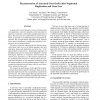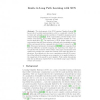65 search results - page 12 / 13 » Comparing evolutionary algorithms to the (1 1)-EA |
WSC
2007
13 years 7 months ago
2007
Statistical selection procedures can identify the best of a finite set of alternatives, where “best” is defined in terms of the unknown expected value of each alternative’...
ICML
1998
IEEE
14 years 6 months ago
1998
IEEE
This paper introduces a new algorithm, Q2, foroptimizingthe expected output ofamultiinput noisy continuous function. Q2 is designed to need only a few experiments, it avoids stron...
CSB
2003
IEEE
13 years 10 months ago
2003
IEEE
As gene order evolves through a variety of chromosomal rearrangements, conserved segments provide important insight into evolutionary relationships and functional roles of genes. ...
GECCO
2003
Springer
13 years 10 months ago
2003
Springer
The development of the XCS Learning Classifier System [26] has produced a stable implementation, able to consistently identify the accurate and optimally general population of cla...
BMCBI
2005
13 years 5 months ago
2005
Background: Exhaustive methods of sequence alignment are accurate but slow, whereas heuristic approaches run quickly, but their complexity makes them more difficult to implement. ...


